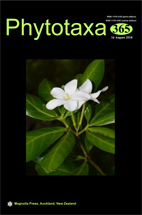Abstract
Clavariadelphus elongatus is described and illustrated as a new species from moist temperate forests of Pakistan. It is characterized by large subcylindrical basidiomata, light yellowish-pink to grayish-reddish orange coloration at maturity and ovoid to ellipsoid basidiospores. A morphological description and line drawings of anatomical structures for the new species are presented and comparison with closely allied taxa discussed. Molecular data inferred from nuclear rDNA ITS regions supports the recognition of the new species reported herein.
References
Castellano, M.A. (1995) Report on fungi. Interior Columbia basin ecosystem management project, pp. 1–76.
Corner, E.J.H. (1950) A monograph of Clavaria and allied genera. Annals of Botany Memoirs 1: 1–740.
Corner, E.J.H. (1970) Supplement to ‘A monograph of Clavaria and allied genera’. Beihefte zur Nova Hedwigia 33: 6.
Donk, M.A. (1931) Revisie van de Nederlandse Heterobasidiomycetae en Homobasidiomycetae-Aphyllophoraceae I. Mededelingen van de Nederlandse Mycologische Vereeniging 18–20: 67–200.
Donk, M.A. (1933) Revisie van de Nederlandse Heterobasidiomyceteae (uitgez. Uredinales en Ustilaginales) en Homobasidiomyceteae-Aphyllophraceae: II. Mededelingen van het botanisch Museum en Herbarium van de Rijksuniversiteit Utrecht 9: 1–278.
Drummond, A.J. & Rambaut, A. (2007) BEAST: Bayesian evolutionary analysis by sampling trees. BMC Evolutionary Biology 7: 214.
https://doi.org/10.1186/1471-2148-7-214
Gardes, M. & Bruns, T.D. (1993) ITS primers with enhanced specificity for Basidiomycetes-application to the identification of mycorrhizae and rusts. Molecular ecology 2: 113–118.
https://doi.org/10.1111/j.1365-294X.1993.tb00005.x
Gernhard, T. (2008) The conditioned reconstructed process. Journal of theoretical biology 253: 769–778.
https://doi.org/10.1016/j.jtbi.2008.04.005
Giachini, A.J., Hosaka, K., Nouhra, E., Spatafora, J. & Trappe, J.M. (2010) Phylogenetic relationships of the Gomphales based on nuc-25S-rDNA, mit-12S-rDNA, and mit-atp6-DNA combined sequences. Fungal biology 114 (2): 224–34.
https://doi.org/10.1016/j.funbio.2010.01.002
Hanif, M. & Khalid, A.N. (2013) Intraspecific rDNA-ITS polymorphism within Clavariadelphus subfastigiatus (basidiomycota: gomphoid-phalloid clade) from Pakistan. International journal of agriculture and biology 15: 465–471.
Hanif, M., Khalid, A.N. & Exeter, R.L. (2014) Clavariadelphus pakistanicus sp. nov., a new club fungus (Basidiomycota: Gomphales) from Himalayan moist temperate forests of Pakistan. Botany 92: 471–476.
https://doi.org/10.1139/cjb-2013-0073
Khan, J., Kiran, M., Jabeen, S., Sher, H. & Khalid, A.N. (2017) Gymnopilus penetrans and G. swaticus sp. nov. (Agaricomycota: Hymenogastraceae); a new record and a new species from northwest Pakistan. Phytotaxa 312 (1): 60–70.
https://doi.org/10.11646/phytotaxa.312.1.4
Kirk, P.M., Cannon, P.F., Minter, D.W. & Stalpers, J.A. (2008) Ainsworth & Bisby’s Dictionary of the Fungi, 10th edn. CAB International, Wallingford, 771 pp.
https://doi.org/10.1079/9780851998268.0000
Löytynoja, A. & Goldman, N. (2010) webPRANK: a phylogeny-aware multiple sequence aligner with interactive alignment browser. BMC Bioinformatics 11: 579.
https://doi.org/10.1186/1471-2105-11-579
Methven, A.S. (1989) Notes on Clavariadelphus III. New and noteworthy species from North America. Mycotaxon 34 (1): 153–179.
Methven, A.S. (1990) The genus Clavariadelphus in North America. J. Cramer, Berlin, Stuttgart.
Miller, M.A., Pfeiffer, W. & Schwartz, T. (2010) Creating the CIPRES Science Gateway for inference of large phylogenetic trees. In: Proceedings of the Gateway Computing Environments Workshop (GCE), New Orleans, Louisiana, 8 pp.
https://doi.org/10.1109/GCE.2010.5676129
Munsell, A.H. (1975) Munsell soil color charts. Munsell Color Inc., Baltimore.
Petersen, R.H., Rahm, E. & Schild, E. (1974) Notes on clavarioid fungi: three new species of Clavariadelphus. Transaction of British mycological society 63 (3): 469–474
https://doi.org/10.1016/S0007-1536(74)80094-X
Rambaut, A. & Drummond, A.J. (2007) Tracer v1.5. Computer program and documentation distributed by the authors. Available from:http://beast.bio.ed.ac.uk/Tracer (accessed 18 October 2016)
Wells, V.L. & Kempton, P.E. (1968) A preliminary study of Clavariadelphus in North America. The Michigan Botanist 7: 35–57.
White, T.J., Bruns, T.D., Lee, S. & Taylor, J. (1990) Amplification and direct sequencing of fungal ribosomal RNA genes for phylogenetics. In: Innis, M.A., Gelfand, D.H., Sninsky, J.J. & White, T.J. (Eds.) PCR protocols: a guide to methods and applications. Academic Press, San Diego, pp. 315–322.
https://doi.org/10.1016/B978-0-12-372180-8.50042-1

